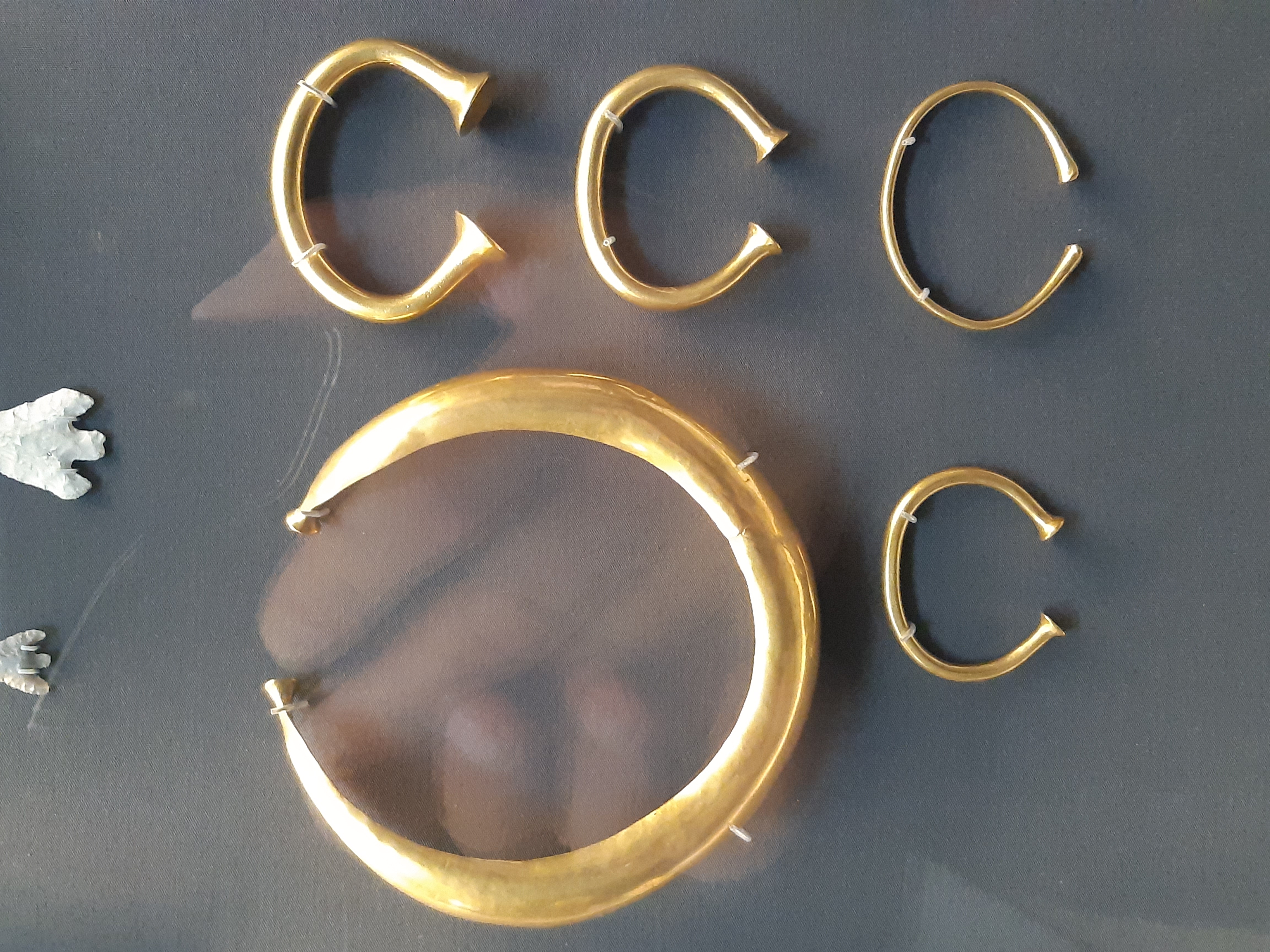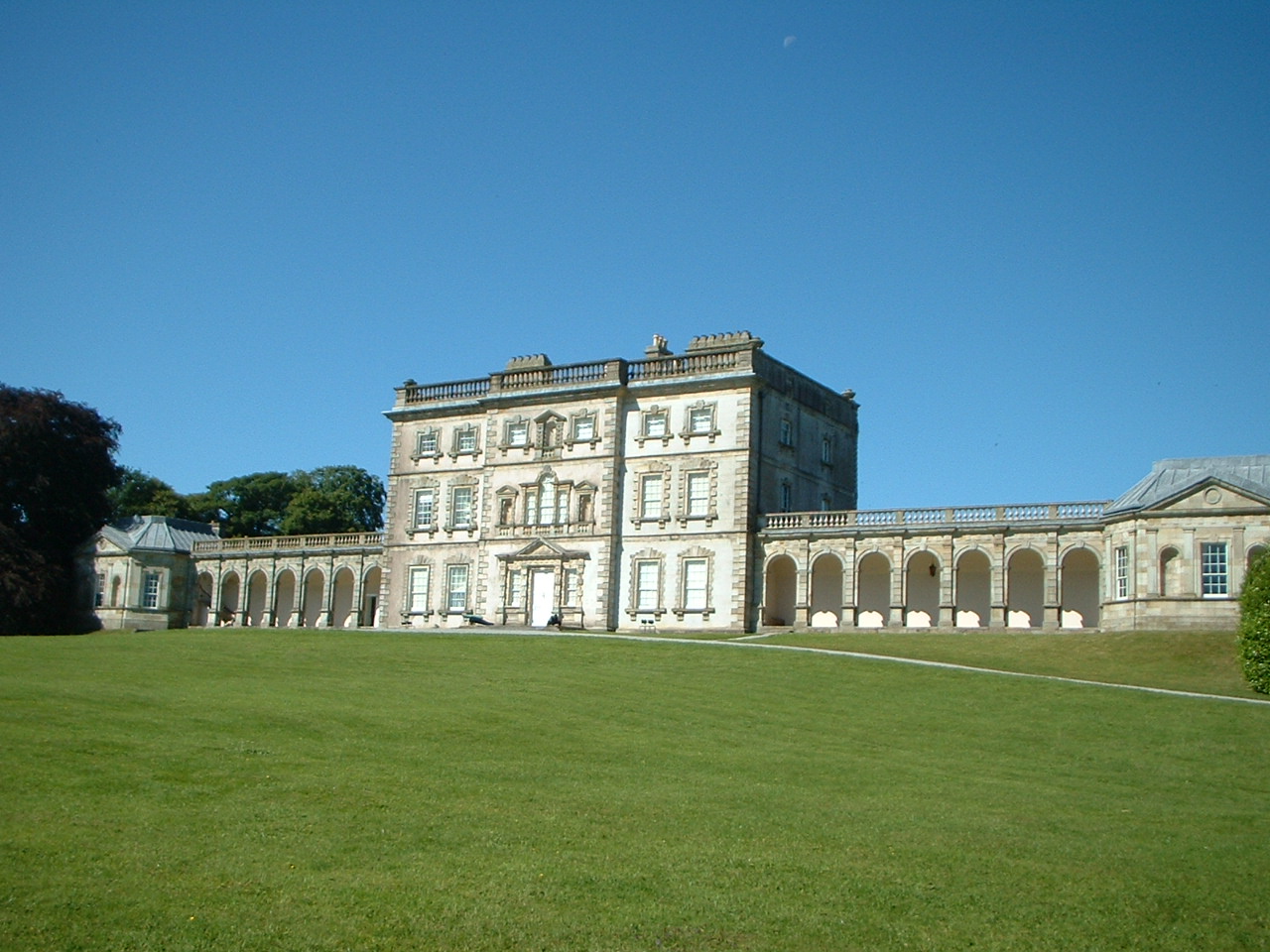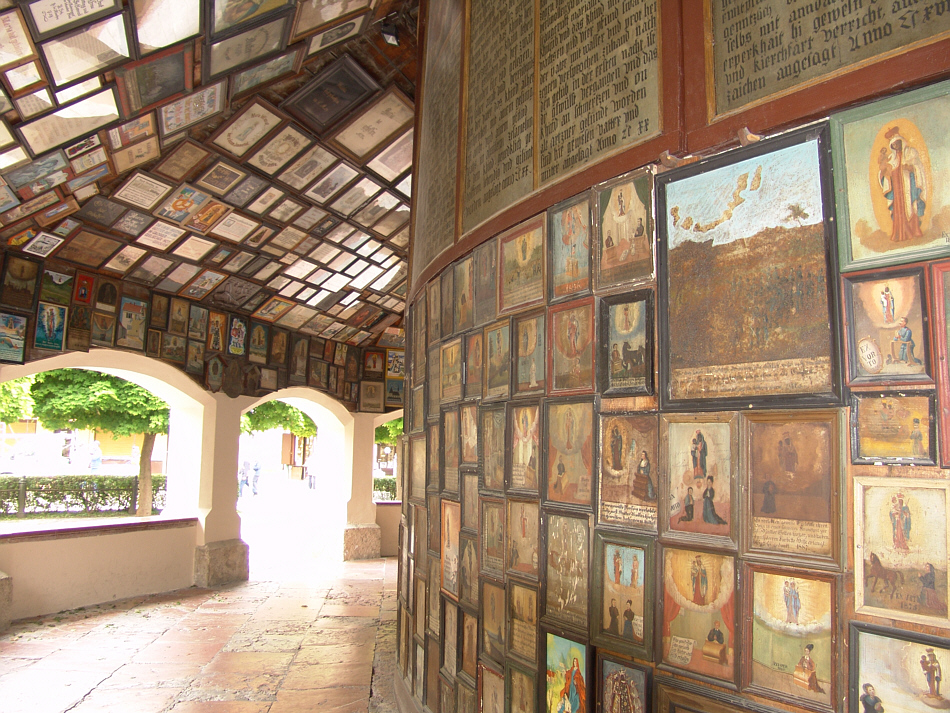|
Mooghaun North Hoard
The Mooghaun North Hoard or ''Great Clare Find'' is the name of an important Bronze Age hoard found at Mooghaun North, near Newmarket-on-Fergus in County Clare, Ireland. Considered one of the greatest Bronze Age hoards of gold ever found north of the Alps, unfortunately most of the treasure was melted down soon after its discovery. What remains of the hoard is currently split between the National Museum of Ireland in Dublin and the British Museum in London. It is no. 11 in '' A History of Ireland in 100 Objects''. Discovery In March 1854, some workers building the West Clare Railway near Newmarket-on-Fergus were realigning a dyke near Mooghaun Lake, when they accidentally uncovered a huge cache of gold jewellery from the Bronze Age. While shifting a stone they brought to light a large cavity in the ground where the treasure was kept. Most of the precious objects were sold to local dealers who melted them down for their bullion value and only 29 out of a total of over 150 obje ... [...More Info...] [...Related Items...] OR: [Wikipedia] [Google] [Baidu] |
William Cole, 3rd Earl Of Enniskillen
William Willoughby Cole, 3rd Earl of Enniskillen, FRS (25 January 180712 November 1886) styled by the courtesy title Viscount Cole until 1840, was an Irish palaeontologist and Conservative Member of Parliament. He also served as the first Imperial Grand Master of the Orange Order from 1866 until his death. He was Grand Master of the Grand Orange Lodge of Ireland from 1846 until his death. Background and education Cole was born into the Ulster branch of ' the Ascendancy', the Anglo-Irish aristocracy. He was the son of John Willoughby Cole, 2nd Earl of Enniskillen and his wife, Lady Charlotte Paget. Lord Cole was educated at Harrow and Christ Church, Oxford. In his youth he began to devote his leisure to the study and collection of fossil fishes, with his friend Sir Philip Grey Egerton, and amassed a fine collection at Florence Court, his home just south-west of Enniskillen. This included many specimens that were described and figured by Agassiz and Egerton. This collectio ... [...More Info...] [...Related Items...] OR: [Wikipedia] [Google] [Baidu] |
Prehistory And Europe Objects In The British Museum
Prehistory, also known as pre-literary history, is the period of human history between the use of the first stone tools by hominins 3.3 million years ago and the beginning of recorded history with the invention of writing systems. The use of symbols, marks, and images appears very early among humans, but the earliest known writing systems appeared 5000 years ago. It took thousands of years for writing systems to be widely adopted, with writing spreading to almost all cultures by the 19th century. The end of prehistory therefore came at very different times in different places, and the term is less often used in discussing societies where prehistory ended relatively recently. In the early Bronze Age, Sumer in Mesopotamia, the Indus Valley Civilisation, and ancient Egypt were the first civilizations to develop their own scripts and to keep historical records, with their neighbors following. Most other civilizations reached the end of prehistory during the following Iron Age. ... [...More Info...] [...Related Items...] OR: [Wikipedia] [Google] [Baidu] |
Collection Of The National Museum Of Ireland
Collection or Collections may refer to: * Cash collection, the function of an accounts receivable department * Collection (church), money donated by the congregation during a church service * Collection agency, agency to collect cash * Collections management (museum) ** Collection (museum), objects in a particular field forms the core basis for the museum ** Fonds in archives ** Private collection, sometimes just called "collection" * Collection (Oxford colleges), a beginning-of-term exam or Principal's Collections * Collection (horse), a horse carrying more weight on his hindquarters than his forehand * Collection (racehorse), an Irish-bred, Hong Kong based Thoroughbred racehorse * Collection (publishing), a gathering of books under the same title at the same publisher * Scientific collection, any systematic collection of objects for scientific study Collection may also refer to: Computing * Collection (abstract data type), the abstract concept of collections in compute ... [...More Info...] [...Related Items...] OR: [Wikipedia] [Google] [Baidu] |
Bronze Age Art
Bronze is an alloy consisting primarily of copper, commonly with about 12–12.5% tin and often with the addition of other metals (including aluminium, manganese, nickel, or zinc) and sometimes non-metals, such as phosphorus, or metalloids such as arsenic or silicon. These additions produce a range of alloys that may be harder than copper alone, or have other useful properties, such as strength, ductility, or machinability. The archaeological period in which bronze was the hardest metal in widespread use is known as the Bronze Age. The beginning of the Bronze Age in western Eurasia and India is conventionally dated to the mid-4th millennium BCE (~3500 BCE), and to the early 2nd millennium BCE in China; elsewhere it gradually spread across regions. The Bronze Age was followed by the Iron Age starting from about 1300 BCE and reaching most of Eurasia by about 500 BCE, although bronze continued to be much more widely used than it is in modern times. Because historical artworks were ... [...More Info...] [...Related Items...] OR: [Wikipedia] [Google] [Baidu] |
Treasure Troves In The Republic Of Ireland
Treasure (from la, thesaurus from Greek language ''thēsauros'', "treasure store") is a concentration of wealth — often originating from ancient history — that is considered lost and/or forgotten until rediscovered. Some jurisdictions legally define what constitutes treasure, such as in the British Treasure Act 1996. The phrase "blood and treasure" has been used to refer to the human and monetary costs associated with massive endeavours such as war that expend both. Searching for hidden treasure is a common theme in legend; treasure hunters do exist, and can seek lost wealth for a living. Burial Buried treasure is an important part of the popular mythos surrounding pirates. According to popular conception, pirates often buried their stolen fortunes in remote places, intending to return for them later (often with the use of treasure maps). There are three well-known stories that helped popularize the myth of buried pirate treasure: " The Gold-Bug" by Edgar A ... [...More Info...] [...Related Items...] OR: [Wikipedia] [Google] [Baidu] |
Prehistoric Objects In The British Museum
Prehistory, also known as pre-literary history, is the period of human history between the use of the first stone tools by hominins 3.3 million years ago and the beginning of recorded history with the invention of writing systems. The use of symbols, marks, and images appears very early among humans, but the earliest known writing systems appeared 5000 years ago. It took thousands of years for writing systems to be widely adopted, with writing spreading to almost all cultures by the 19th century. The end of prehistory therefore came at very different times in different places, and the term is less often used in discussing societies where prehistory ended relatively recently. In the early Bronze Age, Sumer in Mesopotamia, the Indus Valley Civilisation, and ancient Egypt were the first civilizations to develop their own scripts and to keep historical records, with their neighbors following. Most other civilizations reached the end of prehistory during the following Iron Age. ... [...More Info...] [...Related Items...] OR: [Wikipedia] [Google] [Baidu] |
Broighter Gold
The Broighter Gold or more correctly, the Broighter Hoard, is a hoard of gold Artifact (archaeology), artefacts from the Iron Age of the 1st century BC that were found in 1896 by Tom Nicholl and James Morrow on farmland near Limavady, in the north of Ireland (now Northern Ireland). The hoard includes a gold boat, a gold torc and bowl and some other jewellery. The National Museum of Ireland, who now hold the hoard, describe the torc as the "finest example of Irish La Tène culture, La Tène goldworking". Replicas of the collection are kept at the Ulster Museum in Belfast. A somewhat puzzling aspect of the hoard is that scientific analysis suggests the same source for the gold in all the pieces, but they show a great diversity in style, from Celtic to Roman.Wallace, 128-129 A design from the hoard has been used as an image on the 1996 issue of the Northern Ireland One pound (British coin), British one-pound coins and the gold ship featured in a design on the last Éire, Irish com ... [...More Info...] [...Related Items...] OR: [Wikipedia] [Google] [Baidu] |
Dowris Hoard
The Dowris Hoard is the name of an important Bronze Age hoard of over 200 objects found in Dowris, County Offaly, Ireland. Items from the deposit are currently split between two institutions: the National Museum of Ireland in Dublin and the British Museum in London. The hoard mostly of objects in bronze, was probably a ritual deposit, perhaps for religious purposes, though the records of the discovery, by farm labourers in the 1820s, do not allow to be sure if it was one deposit, or a series. Current thinking tends to see it as a series, possibly over a very long period, of ritual deposits into a lake. The importance of the hoard in Irish prehistory has led to the naming of the final phase of the Irish Late Bronze Age (900–600 BC) as the Dowris Phase or period. Over time Irish prehistoric bronzesmiths had become highly adept at casting and working with sheet metal and the Dowris Phase reflects the culmination of this as well as an industrial growth in metalworking. During th ... [...More Info...] [...Related Items...] OR: [Wikipedia] [Google] [Baidu] |
Mourne Mountains
The Mourne Mountains ( ; ga, Beanna Boirche), also called the Mournes or Mountains of Mourne, are a granite mountain range in County Down in the south-east of Northern Ireland. They include the highest mountains in Northern Ireland, the highest of which is Slieve Donard at . The Mournes are designated an Area of Outstanding Natural Beauty and it has been proposed to make the area Northern Ireland's first national park. The area is partly owned by the National Trust and sees many visitors every year. The Mourne Wall crosses fifteen of the summits and was built to enclose the catchment basin of the Silent Valley and Ben Crom reservoirs. Mountains The name ' Mourne' is derived from the name of a Gaelic clan or sept called the ''Múghdhorna''. The common Irish name for the mountains, ''na Beanna Boirche'', may mean "the peaks of the peak district" or "peaks of Boirche" (a mythical king and cowherd). It was historically anglicized as 'Bennyborfy'. Some of the mountains have ... [...More Info...] [...Related Items...] OR: [Wikipedia] [Google] [Baidu] |
Votive Offering
A votive offering or votive deposit is one or more objects displayed or deposited, without the intention of recovery or use, in a sacred place for religious purposes. Such items are a feature of modern and ancient societies and are generally made in order to gain favor with supernatural forces. While some offerings were apparently made in anticipation of the achievement of a particular wish, in Western cultures from which documentary evidence survives it was more typical to wait until the wish has been fulfilled before making the offering, for which the more specific term ex-voto may be used. Other offerings were very likely regarded just as gifts to the deity, not linked to any particular need. In Buddhism, votive offering such as construction of stupas was a prevalent practice in Ancient India, an example of which can be observed in the ruins of the ancient Vikramshila University and other contemporary structures. Votive offerings have been described in historical Roman ... [...More Info...] [...Related Items...] OR: [Wikipedia] [Google] [Baidu] |
Torc
A torc, also spelled torq or torque, is a large rigid or stiff neck ring in metal, made either as a single piece or from strands twisted together. The great majority are open at the front, although some had hook and ring closures and a few had mortice and tenon locking catches to close them. Many seem designed for near-permanent wear and would have been difficult to remove. Torcs are found in the Scythian, Illyrian, Thrace, Thracian, Celts, Celtic, and other cultures of the European Iron Age from around the 8th century BC to the 3rd century AD. For the Iron Age Celts, the gold torc seems to have been a key object. It identifies the wearer as a person of high rank, and many of the finest works of ancient Celtic art are torcs. The Celtic torc disappears in the Migration Period, but during the Viking Age torc-style metal necklaces, now mainly in silver, came back into fashion. Torc styles of neck-ring are found as part of the jewellery styles of various other cultures a ... [...More Info...] [...Related Items...] OR: [Wikipedia] [Google] [Baidu] |






.jpg)


